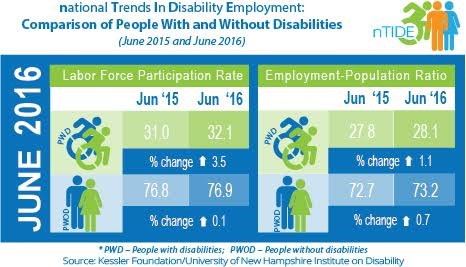WEST ORANGE, N.J., July 8, 2016 (GLOBE NEWSWIRE) -- For the third consecutive month, major economic indicators increased for people with disabilities, according to today's National Trends in Disability Employment – Monthly Update (nTIDE), issued by Kessler Foundation and University of New Hampshire's Institute on Disability (UNH-IOD). Targeted philanthropy is funding diversity projects that are helping Americans with disabilities who are striving to work succeed in the workplace. These projects foster the development of sustainable models for meeting hiring needs, which can be replicated in different sectors across the country.
In the Bureau of Labor Statistics' Jobs Report released Friday, July 8, the employment-to-population ratio for working-age people with disabilities increased from 27.8 percent in June 2015 to 28.1 percent in June 2016 (up 1.1 percent; 0.3 percentage points). For working-age people without disabilities, the employment-to-population ratio also increased from 72.7 percent in June 2015 to 73.2 percent in June 2016 (up 0.7 percent; 0.5 percentage points). The employment-to-population ratio, a key indicator, reflects the percentage of people who are working relative to the total population (the number of people working divided by the number of people in the total population multiplied by 100).
"The improvement in the proportion of people with disabilities working continues to outpace improvements made by people without disabilities." according to John O'Neill, Ph.D., director of employment and disability research at Kessler Foundation. "While three consecutive months of employment growth for people with disabilities is very encouraging news, it does not mean we are out of the woods," he added. There is still a long way to go before people with disabilities reach their pre-Great Recession employment levels, not to mention parity with people without disabilities."
The labor force participation rate for working-age people with disabilities increased from 31 percent in June 2015 to 32.1 percent in June 2016 (up 3.5 percent; 1.1 percentage points). For working-age people without disabilities, the labor force participation rate also increased, albeit very slightly, from 76.8 percent in June 2015 to 76.9 percent in June 2016 (up 0.1 percent; 0.1 percentage points). The labor force participation rate is the percentage of the population that is working or actively looking for work.
"The labor force participation rate went up by more than the employment-to-population ratio, percentage-point wise. This suggests that, not only are more people with disabilities working, but more people with disabilities are looking for work, meaning they are active in the labor market," said Andrew Houtenville, Ph.D., associate professor of economics at UNH.
People with disabilities are being trained and hired for competitive jobs through public-private partnerships supported by targeted grant funding. One example is the Maxing Out Diversity Project operated by OfficeMax/Office Depot and funded by a major Kessler Foundation grant to APSE. OfficeMax/Office Depot worked with APSE to develop a pre-training model that was implemented at four of its distribution centers - Las Vegas, Chicago, Columbus and Dallas. This training model was designed to facilitate career tracks at the distribution centers, as well as in OfficeMax/Office Depot retail stores associated with each of the distribution centers.
Through the Maxing Out Project, 113 people were trained and 67 were hired - 45 of whom are still employed, according to James Emmett, the Project's lead disability consultant. "The Maxing Out Diversity Project demonstrates how active community collaboration and structured pre-training can help job seekers with more significant barriers to employment find meaningful careers," said Emmett, who is currently a corporate disability consultant with the Poses Family Foundation/James Emmett & Company.
In June 2016, among workers ages 16-64, the 4,505,000 workers with disabilities represented 3.1 percent of the total 143,080,000 workers in the U.S.
The next nTIDE will be issued on Friday, August 5, 2016.
Join our new Lunch & Learn series, starting today, July 8 at 12:00PM EST. This live broadcast hosted via Zoom Webinar will offer attendees Q&A on the latest nTIDE findings, provide news and updates from the field of Disability Employment, as well as host invited panelists to discuss current disability-related findings and events. Allison Wohl, Executive Director APSE, joins Dr. O'Neill and Dr. Michael Gamel-McCormick to discuss today's findings. You can join live, or watch the recordings at www.ResearchonDisability.org/nTIDE.
NOTE: The statistics in the National Trends in Disability Employment – Update are based on Bureau of Labor Statistics numbers, but are NOT identical. They have been customized by the University of New Hampshire to efficiently combine the statistics for men and women of working age (16 to 64).
nTIDE is funded, in part, by grants from the National Institute on Disability, Independent Living and Rehabilitation Research (NIDILRR) (90RT5022-02-00 & 90RT5017) and Kessler Foundation.
About Kessler Foundation
Kessler Foundation, a major nonprofit organization in the field of disability, is a global leader in rehabilitation research that seeks to improve cognition, mobility and long-term outcomes, including employment, for people with neurological disabilities caused by diseases and injuries of the brain and spinal cord. Kessler Foundation leads the nation in funding innovative programs that expand opportunities for employment for people with disabilities. For more information, visit KesslerFoundation.org.
About the Institute on Disability at the University of New Hampshire
The Institute on Disability (IOD) at the University of New Hampshire (UNH) was established in 1987 to provide a coherent university-based focus for the improvement of knowledge, policies, and practices related to the lives of persons with disabilities and their families. For information on the NIDILRR-funded Employment Policy and Measurement Rehabilitation Rsearch and Training Center, visit www.ResearchonDisability.org.
For more information, or to interview an expert, contact:
Carolann Murphy, 973.324.8382, CMurphy@KesslerFoundation.org
A photo accompanying this release is available at: http://www.globenewswire.com/newsroom/prs/?pkgid=40782
